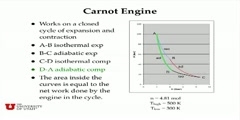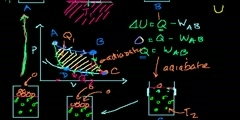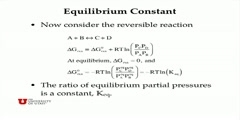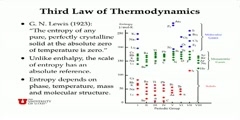Lec 77 - Reconciling Thermodynamic and State Definitions of Entropy
Reconciling Thermodynamic and State Definitions of Entropy Long video explaining why entropy is a measure of the number of states a system can take on (mathy, but mind-blowing).
Video is embedded from external source so embedding is not available.
Video is embedded from external source so download is not available.
Channels: Chemistry (General)
Tags: Reconciling Thermodynamic and State Definitions of Entropy
Uploaded by: khanchemistry ( Send Message ) on 10-09-2012.
Duration: 28m 26s
Here is the next lecture for this course
Lec 75 - Proof: S (or Entropy) is a valid ...
15:38 | 3371 viewsLec 76 - Thermodynamic Entropy Definition ...
15:38 | 5169 viewsLec 32 - MIT 3.091 Introduction to Solid ...
46:03 | 3665 viewsWhat is Entropy and Heat Engines
06:50 | 6172 viewsLec 27 - MIT 3.091 Introduction to Solid ...
48:52 | 3162 viewsLec Last - Potential Energy Surfaces, Tra ...
47:44 | 7232 viewsProof is a valid state variable
15:37 | 6119 viewsWhat is Entropy and Equilibrium
08:21 | 5072 viewsAll About Heat And Entropy
08:40 | 4937 viewsLec 2 - MIT 3.091 Introduction to Solid S ...
43:53 | 8056 viewsLec 3 - MIT 3.091 Introduction to Solid S ...
47:47 | 7354 viewsLec 4 - MIT 3.091 Introduction to Solid S ...
50:14 | 7325 viewsLec 5 - MIT 3.091 Introduction to Solid S ...
51:04 | 6842 viewsLec 6 - MIT 3.091 Introduction to Solid S ...
50:48 | 7368 viewsLec 7 - MIT 3.091 Introduction to Solid S ...
50:24 | 7334 viewsNo content is added to this lecture.
This video is a part of a lecture series from of khan
Lecture list for this course
Lec 2 - Introduction to the atom
Lec 4 - More on orbitals and electron configuration
Lec 5 - Electron Configurations
Lec 6 - Electron Configurations 2
Lec 8 - Groups of the Periodic Table
Lec 9 - Periodic Table Trends: Ionization Energy
Lec 10 - Other Periodic Table Trends
Lec 11 - Ionic, Covalent, and Metallic Bonds
Lec 12 - Molecular and Empirical Formulas
Lec 13 - The Mole and Avogadro's Number
Lec 14 - Formula from Mass Composition
Lec 15 - Another mass composition problem
Lec 16 - Balancing Chemical Equations
Lec 18 - Stoichiometry: Limiting Reagent
Lec 19 - Ideal Gas Equation: PV=nRT
Lec 20 - Ideal Gas Equation Example 1
Lec 21 - Ideal Gas Equation Example 2
Lec 22 - Ideal Gas Equation Example 3
Lec 26 - States of Matter Follow-Up
Lec 27 - Specific Heat, Heat of Fusion and Vaporization
Lec 28 - Chilling Water Problem
Lec 31 - Covalent Networks, Metallic, and Ionic Crystals
Lec 33 - Suspensions, Colloids and Solutions
Lec 35 - Boiling Point Elevation and Freezing Point Supression
Lec 36 - Introduction to Kinetics
Lec 37 - Reactions in Equilibrium
Lec 38 - Mini-Video on Ion Size
Lec 39 - Keq Intuition (mathy and not necessary to progress)
Lec 40 - Keq derivation intuition (can skip; bit mathy)
Lec 41 - Heterogenous Equilibrium
Lec 42 - Le Chatelier's Principle
Lec 43 - Introduction to pH, pOH, and pKw
Lec 44 - Acid Base Introduction
Lec 45 - pH, pOH of Strong Acids and Bases
Lec 48 - Conjugate Acids and Bases
Lec 49 - pKa and pKb Relationship
Lec 50 - Buffers and Hendersen-Hasselbalch
Lec 51 - Strong Acid Titration
Lec 53 - Half Equivalence Point
Lec 55 - Introduction to Oxidation States
Lec 56 - More on Oxidation States
Lec 57 - Hydrogen Peroxide Correction
Lec 62- Exponential Decay Formula Proof (can skip, involves Calculus)
Lec 63 - Introduction to Exponential Decay
Lec 64 - More Exponential Decay Examples
Lec 65 - Macrostates and Microstates
Lec 66 - Quasistatic and Reversible Processes
Lec 67 - First Law of Thermodynamics/ Internal Energy
Lec 68 - More on Internal Energy
Lec 70 - PV-diagrams and Expansion Work
Lec 71 - Proof: U=(3/2)PV or U=(3/2)nRT
Lec 72 - Work Done by Isothermic Process
Lec 73 - Carnot Cycle and Carnot Engine
Lec 74 - Proof: Volume Ratios in a Carnot Cycle
Lec 75 - Proof: S (or Entropy) is a valid state variable
Lec 76 - Thermodynamic Entropy Definition Clarification
Lec 81 - Efficiency of a Carnot Engine
Lec 82 - Carnot Efficiency 2: Reversing the Cycle
Lec 83 - Carnot Efficiency 3: Proving that it is the most efficient
Lec 86 - Hess's Law and Reaction Enthalpy Change
Lec 87 - Gibbs Free Energy and Spontaneity
Lec 88 - Gibbs Free Energy Example
Lec 89 - More rigorous Gibbs Free Energy/ Spontaneity Relationship
Lec 90 - A look at a seductive but wrong Gibbs/Spontaneity Proof
Lec 91 - Stoichiometry Example Problem 1
Lec 92 - Stoichiometry Example Problem 2
Lec 93 - Limiting Reactant Example Problem 1
Lec 94 - Empirical and Molecular Formulas from Stoichiometry
Lec 95 - Example of Finding Reactant Empirical Formula
Lec 96 - Stoichiometry of a Reaction in Solution
Lec 97 - Another Stoichiometry Example in a Solution
Lec 98 - Molecular and Empirical Forumlas from Percent Composition
















